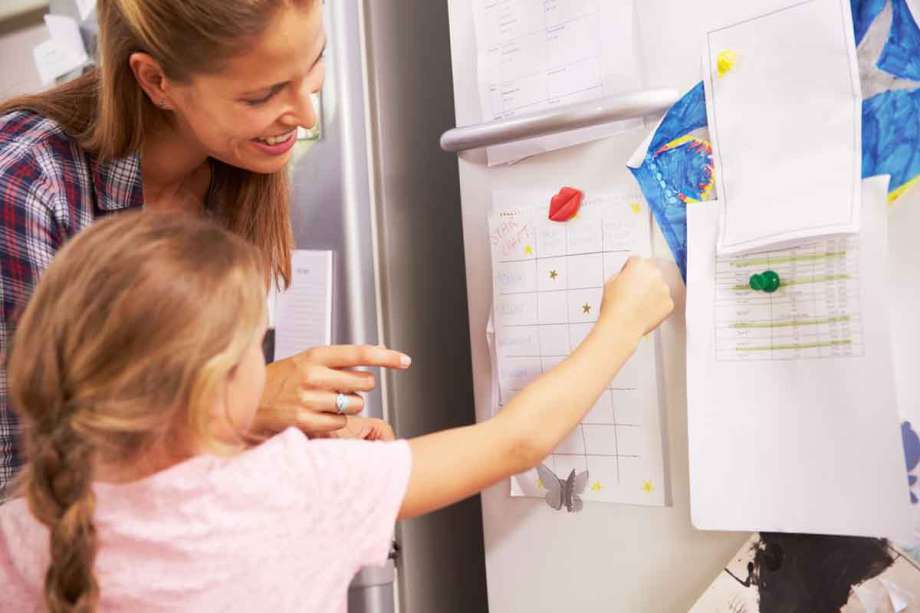How to Use Positive Reinforcement with Kids (Age by Age Guide)

In this article, you will find:
Reward proper behavior
Do kids actually respond better to positive reinforcement?
Children naturally want to explore and are curious about many things. They’ll often test your boundaries to see what happens. They may spit, hit, throw tantrums, disobey rules, make snarky remarks, and call you names.
As frustrated parents, it’s easy to focus on misbehaviors and enforce punishments. However, parents’ negative reactions may actually reinforce kids’ bad behavior.
Instead of immediately grounding kids or taking away privileges, many modern parents are searching for more positive parenting methods.
Related: 10 Positive Parenting Phrases to Use With Toddlers
What is Positive Reinforcement in Parenting?
According to the American Psychological Association Dictionary of Psychology, the definition of positive reinforcement is the following:
An increase in the probability of occurrence of some activity because that activity results in the presentation of a stimulus or of some circumstance.
The procedure of presenting a positive reinforcer after a response.
Positive reinforcement helps accentuate behavior you like to see while taking the emphasis off negative behavior. Positive reinforcement is an effective parenting technique that can help your child improve habits, learn to be responsible, develop a strong character and boost their self-esteem.
In our instructional guide to practicing positive parenting with kids, we’ll give examples of types of positive reinforcement, its benefits, and the results of positive reinforcement on a child’s development, behavior, and relationship with their parents.
How to Use Positive Reinforcement with Kids
In parenting, positive reinforcement is a simple, reality-based technique that can help turn your child’s behavior around — often very quickly.
Understanding how positive reinforcement works and the way that certain positive or negative reactions can influence behavior is essential to incorporating positive reinforcement techniques into your own discipline methods.
Here’s the recipe:
- Your child wants your approval very badly.
- You notice and comment on specific positive behavior and provide natural and logical rewards.
- Your child feels noticed, validated, and approved of, the good behavior increases, and misbehavior is prevented or decreased.
- Your child also begins to recognize the value of his own positive qualities and actions.
Positive reinforcement reinforces what the child is doing right rather than concentrating on what the child is doing wrong. It increases the likelihood that the behavior will be repeated without the use of threats, abuse, shame, punishment, or humiliation.
You shouldn’t wait for your child to do something wrong to correct their behavior. Instead of resorting to disappointment or anger to teach your child a lesson, parents can reaffirm their child’s good deeds and qualities through enthusiasm, descriptive encouragement, and natural, logical rewards.
Good vs Bad Forms of Positive Reinforcement with Kids
Not all praise works as good positive reinforcement. Parents need to be aware of overgeneralizing or over-moralizing their kids’ successes and failures.
Avoid focusing on past negative behavior and stay focused on the present moment when offering praise and comments. For example, you should not say:
“You hung up your jacket, for once!”
This phrasing implies that the child’s positive behavior is an exception.
You should also avoid statements that link the specific behavior to a judgment of the child’s personality or identity. This can cause kids to believe that they are “bad people” when they make mistakes or believe that they are only good if they receive external praise. So an example of what not to do can look like:
“What a good child you are for hanging up your jacket!”
Instead, positive reinforcement should be immediate and specific. For instance, when your child does something without being told, focus on positive behavior:
“John, I noticed you remembered to take your clothes off the floor. Now the puppy won’t be able to chew them.”
Positive Reinforcement vs Punishment
Punishment can be referred to as negative reinforcement. According to the American Psychological Association Dictionary of Psychology, negative reinforcement is defined as the following:
The removal, prevention, or postponement of an aversive stimulus as a consequence of a response, which, in turn, increases the probability of that response.
Both positive and negative reinforcement has the same goal which is to strengthen a desired behavior. However, the difference is that with punishment, something is removed instead of added.
Negative Punishment Creates Fear of Consequences

Let’s look at using punishment vs. positive reinforcement with kids to encourage a child to tidy their room before bed.
Negative reinforcement would involve removing their screen privileges if they don’t clean their room. The second reaction starts with the potential or threat of negative consequences for your child’s lack of action or bad behavior.
The issue with negative reinforcement is that it can build resentment and erode trust in the parent-child relationship leading to frustrating power struggles. Negative reinforcement or excessive punishments can cause children to intentionally defy their parents as a way to retaliate.
Children may be more likely to keep secrets and lie to their parents as they fear punishment. Negative reinforcement can affect the development of morality in children and make them believe they are bad people because of their actions and behavior.
Internal Motivation vs External Motivation
Positive reinforcement would involve letting the child play on their tablet after they have completed the task. The child is motivated by the excitement of the reward and connects the positive feelings of using their tablet with that sense of accomplishment.
Some parents may worry that always bribing kids with the promise of a treat or present will cause them to be spoiled or unmotivated. That’s why you shouldn’t rely on physical rewards alone and regularly incorporate praise and point out the impact actions have on future happiness.
For example, once the chore is done show
“Now that you helped clean your room, Mom has more time to play a board game with you before bed!”
However, as kids grow older their internal motivation and sense of accomplishment will grow, and they shouldn’t need as much external praise from others.
What Are The 4 Types of Positive Reinforcement?
Positive discipline strategies vary depending on your child’s age and the type of behavior you are hoping to praise or discourage. Finding the right type of positive reinforcement for your child is key.
Every child is different and they are motivated by individual needs. For instance, one form of positive reinforcement, such as giving a child gold star stickers on a behavior chart for completing their chores may work for a 5-year-old, but this won’t work for older children or teenagers.
Here are the 4 types of positive reinforcement:
1. Natural Reinforcers
The most effective type of positive reinforcement is a natural reinforcer which involves a sense of self-satisfaction for doing something well.
An example of natural positive reinforcement is when a child puts effort at school, studies for exams, completes assignments on time and focuses during class, they receive good grades and high achievement awards. It helps cultivate self-esteem and grow intrinsic motivation and a sense of agency.
2. Social Reinforcers
Social reinforcers involve the approval and recognition from others. These can be communicated through words of encouragement, verbal praise and specific positive feedback in direct response to the child’s positive behavior. Positive social reinforcement helps a child feel accepted and a sense of belonging.
An example of social reinforcement is when a teacher or parent expresses their approval of a child's efforts by writing or saying, “You have an excellent work ethic” or “Thank you for being patient and caring with your little brother.”
Using specific praise directly following the act helps kids connect the good feedback to the behavior and remember it in the future.
It’s important to not overdo the praise. Here are some tips for using words of encouragement:
- Keep it very specific. “I noticed you worked for an hour on your homework.” “You certainly emptied the dishwasher fast and well!” The more specific you get, the more your child will learn to figure out for herself when she is doing a good job.
- Say it deliberately. Remind yourself to comment on positive behavior. It takes a while to make this kind of commentary second nature, so it will have to be deliberate for a while. It may even feel forced. That’s okay!
- Effort counts. You can give descriptive encouragement for effort even if the results don’t turn out so well. “You worked very hard on your homework, Adam. I’m sure next time you will get the right answer.”
- Focus on improvement. “Your arms have gotten much stronger from all the swimming practice you’ve been doing.”

3. Tangible Reinforcers
Tangible reinforcers involve physical items or physical rewards such as money, toys, treats, and/or candy to reward a child for their behavior. It is important not to focus on the actual reward but to emphasize the satisfaction of doing well as children can grow dependent on this type of positive reinforcement.
Tangible reinforcers can be a powerful tool to help jumpstart motivation but they should not be used regularly.
4. Token Reinforcers
Token reinforcers provide a visual representation of a child’s continuous performance and track their progress toward a goal using a rewards system based on reaching behavior milestones.
For instance, a child is asked to clean their room regularly. Every time they complete the chore, they are given a point that is displayed on a behavior chart. When they reach 5 points, they can redeem their points for something they want.
These can be tangible rewards such as money or experiences such as seeing a movie or going go-karting. Token reinforcers help motivate a child to continue practicing desired behaviors and consistently practice habits.
Long-Term Benefits of Positive Reinforcement for Kids
Positive reinforcement can be an effective positive parenting technique that helps a child develop healthy habits that lead to long-term behavior. Some long-term benefits of positive reinforcement include the following:
Positive Reinforcement Builds a Child’s Character
When a child is reprimanded every time they misbehave, this can condition them to fear making mistakes later in life. But when parents use positive reinforcement, it reframes those behaviors into learning moments. Kids are given the opportunity to embrace failure, identify their strengths and practice perseverance.
When they do a job well, they are rewarded and they will be more inclined to continue doing so or even better. They will feel good about themselves for working hard and achieving their goals which builds self-esteem and confidence.
They are able to hone their skills and master their craft. In turn, they will become responsible, self-sufficient, self-disciplined, resourceful and creative beings.

Positive Reinforcement Helps Kids Manage Their Emotions
When a child is punished for their wrongdoings, it instills a sense of anxiety and fear for their misbehavior. They are conditioned to behave appropriately or to do the bare minimum to avoid punishment. They will grow up feeling that their parents love them conditionally which can be detrimental to their mental health and self-esteem.
However, positive reinforcement allows parents to teach children how to manage their emotions during difficult moments. Instead of jumping to punishment, parents can validate their emotions, help problem-solve and coach them through their challenging experiences.
Positive Punishment Makes Parents More Positive Too
Punishing a child can create feelings of distress, guilt, and shame for the parent. No parent wants to intentionally make their child feel bad.
Positive reinforcement works by motivating your child to repeat target behaviors with positive attention instead of threats, force or hurtful words. Rather than putting parents and kids at odds, the lesson becomes a positive experience on both sides.
Examples of Positive Reinforcement by Age
Parents of toddlers and younger kids need to use different examples of positive reinforcement than parents of older kids. Be mindful of the types of positive reinforcement that work for your child’s specific needs and development stage. Here are some examples of positive reinforcement for each age group:
Toddlers (2 to 4 years old)
During early childhood, it’s important to reinforce positive behaviors and recognize them at the moment.
- Compliments or praise when they are doing something right
- Words of encouragement when they are behaving appropriately
- Active listening including nodding, eye contact, and showing that you understand them
- Physical affection or gestures such as clapping, cheering, high-fives, thumbs-ups, hugs, kisses, pats on the back, etc.
- Redirect unwanted behaviors by offering alternatives, removing triggers and distracting them
- One-on-one quality time such as reading a book or playing a game
School-Aged Children (5 to 10-year-olds)
Limits and structure should be provided and communicated clearly for young children so they understand what is and isn’t appropriate behavior.
- Words of encouragement and praise
- Physical affection
- Sticker charts
- Calendar that tracks their goals with meaningful rewards for milestones
- Toys, gadgets or other items your child desires
Tweens (10 to 12-year-olds)
At this stage, it’s important to build trust with your tween by keeping promises and following through on consequences. Instead of punishing your tween, focus on the following positive reinforcement strategies:
- Increased responsibilities and autonomy to make them feel like an important and valuable household member
- Experiences your child desires such as going to a theme park, going to the mall, attending or hosting sleepovers, etc.
- Open discussion in problem-solving
- Privileges such as screen time, video games, phones, going to a friend’s house, etc.
Teens (13+)
It’s important to stay connected and have open lines of communication with your teen. Some parenting tips to help reinforce this include the following:
- Respect their privacy by giving them time and space for themselves
- Schedule quality one-on-one time to get to know your child
- Give your child a safe space to talk to you about difficult topics
- Have rituals and set schedules of reinforcement that help keep your child connected with the family and give them an opportunity to share such as pizza nights, boardgame nights, taco Tuesdays, holidays and birthday celebrations
Positive reinforcement is an effective strategy that parents can try with their children during challenging moments.
For even more advice of how to practice positive parenting and discipline strategies with kids, check out our Age-by-Age Guide to Setting Discipline Consequences for Kids.

